![]()
The Requiem and its origins
The commission for the Requiem
The Requiem and its performance
A controversial incident
The Invalides in pictures
This page is also available in French
![]()
The Hôtel des Invalides was built between 1671 and 1706 on the instructions of Louis XIV who wanted to found an institution for the care of wounded and retired soldiers and officers. To this monumental complex was added a church, Saint-Louis des Invalides, crowned by the no less imposing dome, built between 1677 and 1708. At the end of the XIXth century, after the transfer of Napoleon’s remains, the Invalides were divided into two parts: the dome on one side, and on the other the rest of the church. It was at the church of the Invalides that took place the first performance of the Grande Messe des Morts (the Requiem) on 5 December 1837, under the direction of Habeneck.
As Berlioz relates in his Memoirs (chapter 46) in connection with the commission he received in March 1837, the text of the Requiem was ‘a prey he had long coveted’. The genesis of the Requiem had a long history stretching over a decade. The starting point was the Messe solennelle of 1824-1825, first performed at the church of Saint-Roch in Paris (10 July 1825) then for a second time at Saint-Eustache (22 November 1827). Though successful – it brought its author to public notice for the first time – Berlioz became dissatisfied with the work and discarded it, but he evidently felt that the idea of a large choral work had potential that should be explored. One movement, the Resurrexit, he initially salvaged from the Mass and revised, and it was performed twice at the Conservatoire (26 May 1828, 1 November 1829). It was also among the pieces he submitted to the Institute as one of the compositions he was required to send from Rome during his stay there in 1831-1832. The section Et iterum venturus est of the Resurrexit anticipates, in a very condensed form, the music of the Tuba mirum of the later Requiem, and the Requiem also utilises and develops a number of passages from the earlier Mass, as was shown by the unexpected discovery in 1991 of a copy of the lost work in a church in Antwerp.
A further hint comes just on the eve of Berlioz’s departure to Italy. After the success of the Symphonie fantastique, his first major orchestral work, Berlioz was exploring further possibilities. ‘During my exile [in Italy] I will attempt to write something on a grand scale; I will try to realise an immense project that I have been pondering, and on my return we will stir up the musical world in a strange way’, he wrote to Stephen de la Madelaine (CG no. 200, 30 December 1831). When he arrived in Nice in April 1831, his very first letter to his family alluded to the project incidentally: ‘I am going to undertake some immense work’ (CG no. 219, 21 April). The project had in fact already started to take concrete shape during his second passage in Florence that same month, just before he moved on to Nice, and it may be that the stimulus came from the two funerals he witnessed during his stay there and which he describes with macabre fascination (CG no. 223; Memoirs, chapters 35 and 43, chronologically misplaced). The first detailed mention of the project comes from a letter to his friend Humbert Ferrand when Berlioz was now back in Rome (CG no. 234, 3 July [see also vol. VIII]):
[…] I had a large-scale project which I would have liked to carry out with you; it concerns a colossal oratorio, to be performed at a musical festival in Paris, at the Opéra, or the Panthéon or the courtyard of the Louvre. It would be called The Last Day of the World. I wrote the plan in Florence and part of the text three months ago. It would require 3 or 4 solo performers, a chorus, an orchestra of sixty players in front of the theatre, and another one of two or three hundred players at the back of the stage and arranged on an amphitheatre.
Mankind, having reached the last degree of corruption, indulges in every kind of outrage, despotically ruled by a sort of Antechrist… A small band of righteous men, led by a prophet, stands out in the midst of this general depravity. The despot torments them, abducts their virgins, tramples on their beliefs, and tears up their sacred books during an orgy. The prophet comes to reproach him with his crimes and announces the end of the world and the last judgement. The irritated despot throws him in jail, and, surrendering again to impious pleasures, is surprised in the midst of a feast by the terrible trumpets of the resurrection; the dead emerging from their tombs, the distracted living screaming in terror, the shattering of the worlds, and the angels roaring in the skies, form the finale of this musical drama. As you can imagine, entirely novel means must be used. Apart from the two orchestras, there would be four groups of brass instruments placed at the four corners of the performance. Instruments and singers would be used in wholly novel ways and a thousand possibilities that cannot be achieved with ordinary means would shine forth from this harmonic mass.
See whether you have the time to write this poem, which suits you perfectly, and in which I am sure you will be magnificent. Very few recitatives… few solo arias… Avoid noisy scenes and those which might require brass instruments; I only want to bring them in at the end. Look for contrasts… religious choruses mixed with dancing choruses; pastoral scenes, scenes of wedding and drinking, but removed from the beaten track; well, you understand…
We cannot flatter ourselves that we will get this work performed when we like, particularly in France; but sooner or later there should be a way. […]
Virtually all the detailed evidence about the plan comes from letters addressed to Ferrand. Berlioz, still in Rome, wrote to him again the following year submitting the idea once more, since Ferrand had apparently not received the earlier letter (CG nos. 257, 267, 8 January and 26 March). Ferrand expressed interest in the plan, but proved in the event to be an unreliable collaborator, as emerges from subsequent letters of Berlioz to him later in the year. On 10 October, from La Côte-Saint-André (CG no. 288):
[…] I dare not hope that you have got something from our great dramatic undertaking to show me, though you had promised this to me. […]
On 3 November, from Lyon and on his return journey to Paris (CG no. 289):
[…] I am sure you are not doing anything about our great work; and yet life is rushing by and by the time it is over I will not have achieved anything great. […]
Back in Paris Berlioz did not give up the idea, as two letters of 1833 show, both of them addressed to Ferrand (CG nos. 338 & 342):
(12 June) […] I am actively involved with the project for an opera which I wrote to you about in a letter from Rome, a year and a half ago. As you have not found it possible to overcome your laziness to set to work in the intervening period, I despaired of you and turned to Émile Deschamps and Saint-Félix who are busy at work. I hope you will not hold it against me, as I have been very patient. […]
(30 August) […] Véron [the director of the Opéra] has refused The Last Day of the World. He does not have the courage. I will be sending you the overture to the Francs-Juges. […]
According to an unpublished and undated letter (mentioned in CG I p. 543-4 n. 3) Berlioz submitted at some time the idea to Auguste Barbier, one of the librettists of Benvenuto Cellini, but nothing came of this. The whole project was shelved, though seemingly not forgotten, and as the sequel shows Ferrand remained associated in Berlioz’s mind with the idea of a work about the Day of Judgement, even though he had failed to fulfill his promise of a libretto.
![]()
Years later, in 1837, Berlioz received an unexpected commission, as he relates to his father (CG no. 490, 8 March):
[…] In the meantime I have just come from the office of the Minister of the Interior, who wants to commission from me a large composition for the anniversary of the death of Marshal Mortier etc., at the Invalides. I was going to see him on some other matter, but he gave me this news without warning; I asked to be given a relatively free hand for the forces required for the performance, and he seems inclined to grant this. At any rate, the business will be concluded very soon, and this is necessary so that I have the time to write my work between now and July 28th. I am only worried at the excitement stirred in me at the thought of the subject and of the four or five hundred performers I will have under my orders. What a Dies irae!!! […]
The following month Berlioz wrote to Humbert Ferrand (CG no. 493 [see vol. VIII], 11 April):
[…] In the meantime, I am now writing a Requiem for the anniversary of the death of the victims of Fieschi. It is the Minister of the Interior who has requested this from me. For this immense undertaking he has offered me four thousand francs. I accepted without comment, only adding that I need five hundred performers. The Minister was at first rather taken aback, but permission was granted, though my army of musicians was reduced by about fifty. So I will have at least 450. Today I am finishing the prayer for the dead, starting with the Dies Irae and finishing with the Lacrymosa; this is sublime and gigantic poetry. At first I was intoxicated, then I took charge and got on top of my subject; I believe now that my score will be fairly grand. You understand how much this ambitious word implies to justify my using it; yet if you came to hear me in July, I have the presumption to believe that you would forgive me. […]
The following week he wrote to his sister Adèle (CG no. 495, 17 April):
[…] I cannot make any visits, as I am exclusively occupied from morning to evening with my Requiem which hardly allows me to do necessary work on feuilletons. After a few obstacles put up by Cherubini who wanted to get a newly composed Requiem of his performed at the Invalides, the business has been concluded honorably for him (Cherubini) and for M. de Gasparin who had OFFERED to me to do this work.
The Minister asked me whether I would accept four thousand francs; I thought it inappopriate to haggle on this occasion, though the sum offered is rather mean, given that the expenses for the performance will be huge. I have demanded 500 musicians and will be getting four hundred and thirty.
In sum the ministerial order was signed three weeks ago and I have the copy in my desk, so there is no further danger on that side. In two months I will have finished, I hope. I had difficulty in getting on top of my subject; in the first days the poetry of the Prayer for the dead had intoxicated and excited me to such an extent that nothing clear was coming to mind, my head was in ferment, I was feeling dizzy. Now the eruption is under control, the lava has dug its bed and God willing all will go well. It is a great undertaking. I will probably incur once more the reproach of innovation for having ventured to restore to this branch of art a truthfulness that Mozart and Cherubini often seem to me to have strayed from. Then the musical forces are combined in tremendous ways that fortunately have not been attempted before, and which I believe I am the first to have imagined. […]
By the summer the work was completed and rehearsals were underway, but then there was an unexpected setback: without prior warning the government cancelled the project altogether. On the day of the cancellation Berlioz wrote to Bottée de Toulmon, the librarian of the Conservatoire (CG no. 502, 18 July):
You are extremely kind to have thought of writing to me. It is true that this time the wave was a high one and despite my habit of letting them crash over my head without fear of drowning, I felt for a moment that I was going to lose my breath. But now it is over… and I am ready to start again. The work exists, and that is already something. We will surely find an opportunity to get it performed later. The sectional rehearsals for the chorus were going so well! In truth Hell must be interfering.
Damn it all!!!
But, as I told you, I challenge them to outdo me in patience. […]
Two days later he wrote to Franz Liszt, who was in Switzerland at the time (CG no. 504, 20 July):
[…] You may have already heard of the new hammer-blow which has just hit me! Fortunately I have a solid head, and it would need quite a tomahawk to break it. After three deays of indecision the council of ministers has definitely cancelled the funeral ceremony at the Invalides. No more talk of the heroes of July, woe to the vanquished, and woe to the victors! As a result, after three sectional rehearsals of the chorus, I was informed by accident (since I was being allowed to carry on) that the ceremony would not be taking place and that as a result my Requiem would not be performed. Tell me whether that is not enough to make one snort like a whale! Everything was going as intended and I was sure of my ground, the band of 420 musicians was prepared and tuned like one of your excellent Erard pianos, nothing was missing, and I believe that quite a few things were about to be heard for the first time.
Politics intervened to put everything straight. I still feel rather sick about it. Those are the risks that art faces when it accepts the assistance of a government that is as insecure as our present one. But in the absence of any other there is no option but to accept its support, unreliable as it may be. Ah! representative governments, and cheap ones at that, what a stupid farce! […]
To his father Berlioz expressed his frustration (CG no. 506, 29 July):
[…] But that is not all; now they have to pay for the expenses I have incurred, and M. de Montalivet is good enough to acknowledge their existence. First there are 4000 francs for myself, then 3800 francs for the expenses of copyists, and in addition the cost of three sectional rehearsals of the chorus. I was getting ready, everything was going according to plan, I would never have been performed in such a way, and it was wonderful to see how these masses of singers were catching fire. Unfortunately I was unable to get as far as the general rehearsal, and as a result I have not even been able to get the musicians acquainted with this immense score which arouses their curiosity so much. I call that sort of behaviour on the part of the government outright robbery. My present and my future are being stolen from me, as this performance had great consequences for me. Under the Empire a minister would not have dared to behave in this way, and had he done so I believe Napoleon would have called him back to order. I repeat, this is daylight robbery.
They approach me and ask whether I am prepared to write this work, I lay down my (musical) conditions, they accept them. They offer me 4000 francs, I do not refuse them. I am given a written promise of a performance on 28 July; I complete the music, everything is ready, and they refuse to go any further. The government excuses itself from keeping the most important clause of the contract they made with me. That is an abuse of trust, an abuse of power, a dirty trick, a piece of humbug, an act of robbery.
Now I have on my hands what to me is the greatest musical work ever written, like Robinson with his canoe, and I am unable to launch it. I need a vast church and four hundred musicians. […]
![]()
For the next few months Berlioz was busy coping with the serious financial consequences of the cancellation (CG nos. 511, 512). Then in October an unexpected opportunity arose: on the 17th General Damrémont, who was in charge of the French army besieging Constantine in Algeria, was killed, and on the 23rd it was announced that the city had been captured. Berlioz mobilised his supporters to urge the government to perform the Requiem at a public ceremony to commemorate the event (CG nos. 513-15), and was eventually successful. On 14 November wrote to his mother (CG no. 517, cf. 518):
[…] The two Ministers (of the Interior and of War) have finally signed yesterday the decree which designates my Requiem for the funeral service for General Damrémont. I fought hard for a week to obtain the sum I need, and now I have it, at least in the form of an official promise. The Minister of War is granting 10,000 francs for the performance, and the Minister of the Interior is taking responsibility for the payment of the 8,700 francs that are owed to me for the composition, copying and rehearsals done in July. This does not prevent them from making cruel cuts to my orchestra and chorus, so that instead of 400 musicians I will only have a total of 270 men, women and children. The ceremony should be very fine, and I hope all goes well. The day has not yet been fixed, as they are waiting for a wire announcing the arrival of the body at Toulon. […]
The performance eventually took place on 5 December, and was by all accounts a notable success. Two days later Berlioz wrote to his father (CG no. 523, 7 December):
We too have captured Constantine, the day before yesterday! I mean the musical Constantine. I have been unable to find a single minute to write to you. Two days before the ceremony the performance was causing me great concern, but it was perfect. The success was immense and universal, I can assure you without any illusions, and was shared by both the musicians and the general public. The Duke of Orleans let it be known to me that he had found my work very beautiful and that he had never been so moved by music. The fiercest of my opponents are keeping quiet, the less determined have been routed and are now joining the ranks of my supporters. Out of all the papers I read yesterday thirteen were for and two against (le Corsaire and le Constitutionnel), and even then le Corsaire was not present at the ceremony as is proved by the factual errors in their report, and le Constitutionnel wanted to take revenge for an article I wrote two years ago on Herold [Journal des Débats, 27 September 1835; reprinted in Critique Musicale II, pp. 287-92]. These are the inevitable advantages of being a professional music critic. I have lost count of the letters of congratulation I have been receiving since yesterday, and all my friends are in an indescribable state of excitement. There is no doubt that it had an extraordinary effect; at the passage on the Last Judgement one of our women choristers went hysterical, and the priest dissolved in tears at the altar. Fifteen minutes later this good man was still crying in the vestry. Wherever music is being discussed the topic of conversation is to decide whether my Requiem is greater or not than all previous settings of the text. Out of a hundred musicians apparently ninety take the view that it is.
As for comparing the impact of yesterday’s performance with that made previously on comparable occasions, this is quite impossible. What a pity for me that neither you nor any member of my family happened to be in Paris. […]
Le Corsaire talks of the solo by Mlle Falcon in my mass, but there is no solo for a woman singer, and Mlle Falcon was not even present. Le Constitutionnel and the Journal de Paris mention the solo by Lablache, but he was not present either, and there is no solo for a bass singer.
No matter; these are occupational hasards when you are a prominent critic and you have also the good or bad fortune of writing for the Journal des Débats. You should be pleased, father, and so should you, my mother and sisters, for this is the greatest and most difficult success I have obtained to this day. I will send you all the papers tomorrow. I regret I am unable to send you the letters as well; I have just received a charming one from Rubini [CG no. 519], another one from the marquess of Custine, and another one from Legouvé [CG no. 522]. Farewell, dear father, all is well everywhere. Harriet wept copiously yesterday, but tears of joy do not cause any great pain. Louis is thrilled with his father’s great trumpets…
I am reopening my letter to tell you that the Minister of War has just written to me an extremely warm letter of congratulations and compliments [CG no. 521].
Ten days later Berlioz wrote to Humbert Ferrand (CG no. 528, 17 December):
[…] This is how things went. The Requiem was well performed, and its impact on the vast majority of the audience was tremendous. The minority which did not feel or understand anything is at a loss what to say. The mass of the newspapers have been excellent, apart from Le Constitutionnel, le National and la France, where I have close enemies. I missed you, my dear Ferrand, I believe you would have been very pleased; it was exactly what you were dreaming of by way of sacred music. It is a success which makes me more widely known, and that is what mattered most; the impression made on people of the most divergent feelings and habits has been electrifying; the priest at the Invalides went on weeping at the altar for fifteen minutes after the ceremony, he embraced me at the vestry and dissolved in tears. At the moment of the Last Judgement the terror caused by the five orchestras and the eight pairs of timpani which accompany the Tuba Mirum is beyond description; one of the women choristers was hysterical. Truly it was a moment of formidable grandeur. You have read the letter from the Minister of War; I have received I know not how many others of the kind you sometimes write to me, but without the friendship and poetry. Among them one from Rubini [CG no. 519], one from the marquess of Custine, one from Legouvé [CG no. 522], one from madame Victor Hugo [CG no. 526], and one from d’Ortigue (that one is really crazy). Then goodness knows how many from various artists, painters, musicians, sculptors, architects, writers. Ah! Ferrand, it would have been a beautiful day for me to have you by my side during the performance. The Duke of Orleans, according to his aides, has also been deeply moved. […]
Soon it will perhaps be the turn of the Opéra; this success has helped my interests very nicely; the whole tribe of singers and choristers is on my side, even more than the orchestra. Habeneck himself is completely won over. As soon as the score is engraved you will receive a copy. […]
Other letters of congratulation, not mentioned by Berlioz, have survived: one from Louise Vernet who together with her mother attended the ceremony (CG no. 520), and another from Franz Liszt who was in Milan and had read newspaper reports of the occasion (CG no. 525). Berlioz noted the generally favourable reaction of the press: one illustration of this is the article in the Charivari of 6 December 1837 (in French) which is reproduced on this site.
![]()
The letters written at the time by Berlioz to his father and to Humbert Ferrand, and the contemporary articles in the press, all agree that the performance went well, and none makes any mention of any particular problems during the execution or of any misdemeanour on the part of the conductor Habeneck. Yet years later Berlioz related that a serious incident had threatened to cause disaster at a critical moment of the performance: at the start of the Tuba mirum and the entry of the four brass bands Habeneck put down his baton to take a pinch of snuff, and Berlioz stepped forward to conduct the musicians till the end of the movement. He suspected Habeneck of having deliberately tried to wreck the performance. The story was told by Berlioz in his posthumous Memoirs (chapter 46), but was mentioned by him for the first time in 1859 in his serialisation of excerpts from his Memoirs in Le Monde Illustré (16 April, pp. 250-1). It also appeared before this in 1856 in a very condensed form, in a short biography of Berlioz by Eugène de Mirecourt, which was based on a reading of the unpublished manuscript of the Memoirs (p. 52). In a letter to Humbert Ferrand shortly after the publication of 1859 Berlioz refers to this: ‘The latest issues contain the story (much watered-down) of the crime perpetrated on my by Cavé and Habeneck, on the occasion of the first performance of my Requiem. This is causing quite a stir’ (CG no. 2368, 28 April 1859). The letter implies that Ferrand was familiar with the incident which Berlioz must have related to him previously. To the evidence of Berlioz should be added the testimony of Charles Hallé, a close friend of the composer, who was in Paris at the time and says he was present at the performance: in his own memoirs he explicitly supports the account given by Berlioz (though he discounts the motivation that Berlioz ascribes to Habeneck).
The episode is a well-known crux and has long been treated as a test-case of the truthfulness and reliability of the Memoirs: some (such as Adolphe Boschot), arguing from the silence of contemporary sources, have dismissed it as pure fabrication on the part of Berlioz, while others (such as Julien Tiersot) have defended the accuracy of his account. Readers may be referred to the discussion by Pierre René-Serna on this site, who supports the approach of Tiersot, and to the note by David Cairns, who suggests the incident may have taken place at the general rehearsal rather than the actual performance (David Cairns, The Memoirs of Hector Berlioz, London 1969, pp. 594-5; paperback edition, Panther Books 1970, pp. 744-6). It must be admitted that on any interpretation the available evidence raises questions. If the incident did take place as related by Berlioz, which seems most likely in the light of Hallé’s testimony, then the silence of all the contemporary evidence, including that of Berlioz himself, is surprising. It was only in retrospect that Berlioz attached to the episode an importance and significance that seems to have passed unnoticed at the time.
![]()
After its first performance in 1837 at the Invalides, the Requiem was performed complete in Paris three more times in Berlioz’s lifetime (1846, 1850, 1852), all at the church of Saint-Eustache; outside France is was performed complete only once (at St Petersburg in 1841). The work meant a great deal to Berlioz. Late in his career, the publication of a new and corrected edition of the score by Ricordi in Milan prompted him to write to Humbert Ferrand (CG no. 3209, 11 January 1867):
[…] Tell me also whether you have the full score of my Mass for the dead. If I was threatened with seeing all my works burnt, except for one score, it would be for the Mass for the dead that I would beg exemption. A new edition of the work is being published at the moment in Milan; if you do not have it, I think I could send it to you in six or seven weeks. […]
![]()
See also the articles on the Requiem published by Julien Tiersot in Le Ménestrel in January-February 1904 as part of his Berlioziana series, which are reproduced on this site.
![]()
Unless otherwise stated, all the modern photographs reproduced on this page were taken by Michel Austin in 2000; other pictures have been scanned from engravings and postcards in our own collection. © Monir Tayeb and Michel Austin. All rights of reproduction reserved.
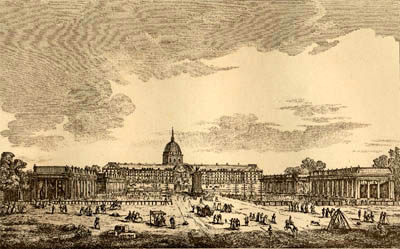
The above late 19th century engraving is based on an earlier one by Bonvalet after a drawing by Bance. The picture shows the 1806 Exposition universelle of Paris located on the esplanade of the Invalides.
The following four engravings by Pugin were published in London in the “Paris and its environs” series of engravings in 1829-1831. Pugin gave their individual titles in French.
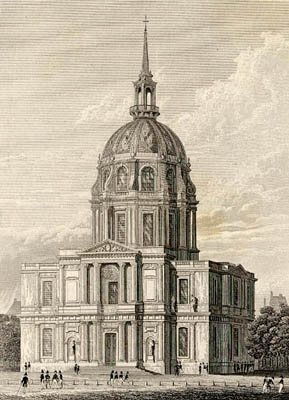
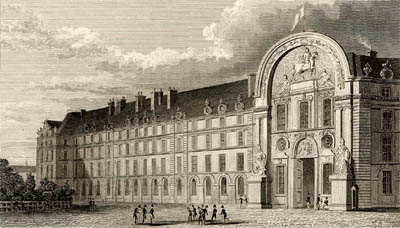
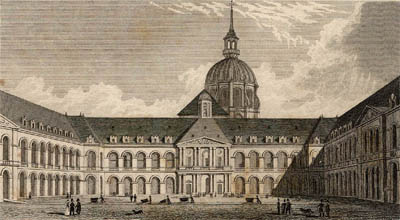

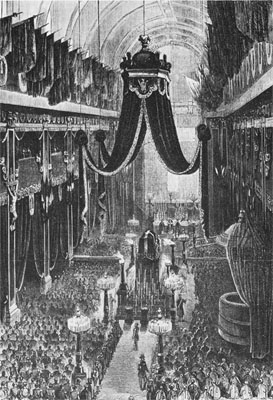
The above engraving shows the funeral service for General Damrémont at which the Requiem was performed for the first time. The original copy of this engraving is in the Bibliothèque Nationale de France in Paris; the image here is courtesy of Hector Berlioz (Librairie Hachette, 1973, page 103), a copy of which is in our own collection.
A report in Le Figaro, published on 6 December 1837, describes the decorations inside the chapel thus:
The inside of the nave presented a spectacle of the greatest magnificence. All the windows and openings had been blocked and padded; there was total darkness, and the pale gleam of the numerous candles of yellow wax stood out sadly against the dark background.
Silver lamps of antique shape hung from the crown of the arches of the galleries, draped with large black curtains decorated with white fringes. Silver stripes enhanced the architecture and the place of the pilasters which disappeared under the thick tapestry. Between the columns hung trophies of distinctive arms with a shield bearing the name of an officer who had killed in the campaign in Africa. A long track of fire flickered on the cornice of the bays and the mouldings of the organ.
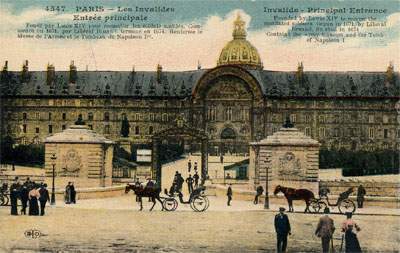
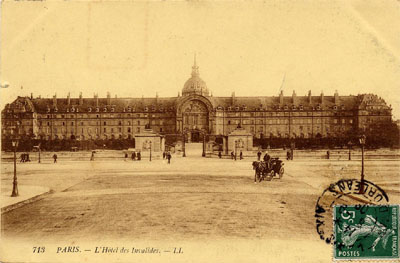
The above postcard was posted on 8 September 1908.
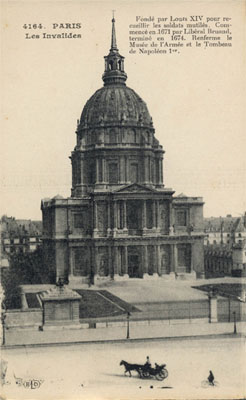
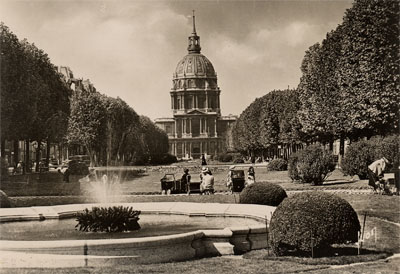
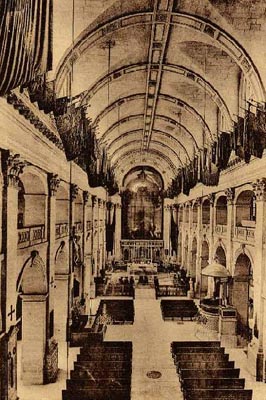
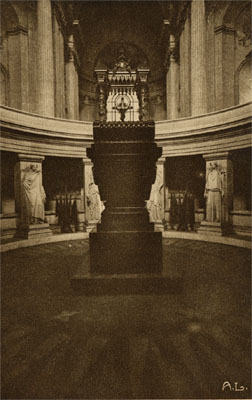
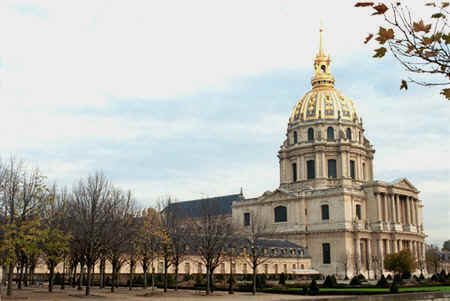

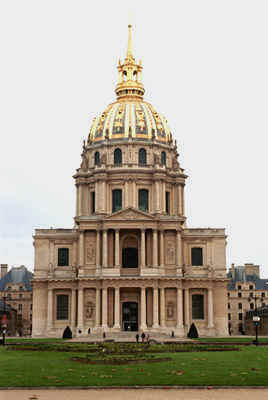
![]()
© (unless otherwise stated) Monir Tayeb and Michel Austin for all the pictures and the text on this page.
Copyright notice: The texts, photos, images and musical scores on all pages of this site are covered by UK Law and International Law. All rights of publication or reproduction of this material in any form, including Web page use, are reserved. Their use without our explicit permission is illegal.